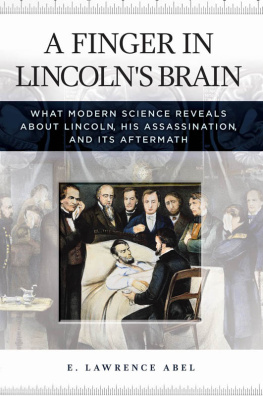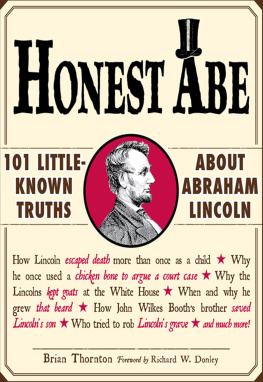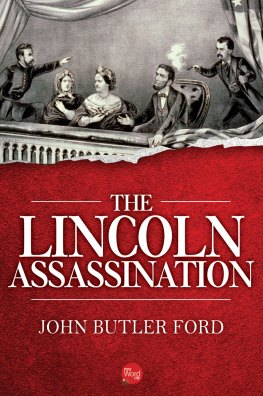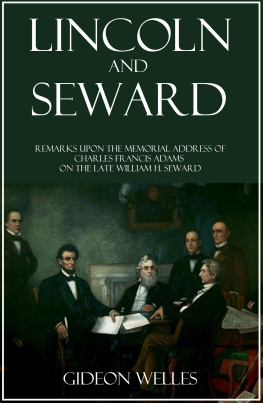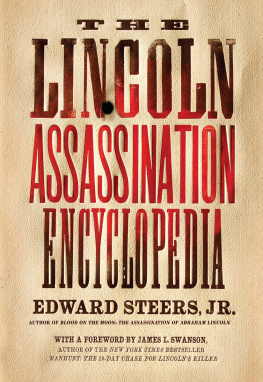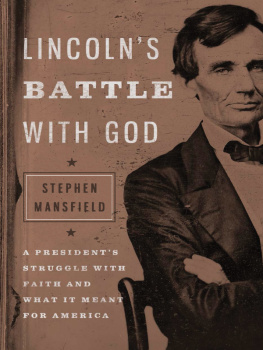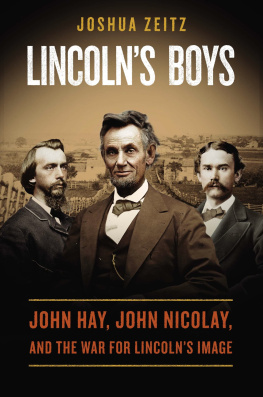A Finger in Lincolns Brain
A Finger in Lincolns Brain
What Modern Science Reveals about Lincoln, His Assassination, and Its Aftermath
E. Lawrence Abel

Copyright 2015 by E. Lawrence Abel
All rights reserved. No part of this publication may be reproduced, stored in a retrieval system, or transmitted, in any form or by any means, electronic, mechanical, photocopying, recording, or otherwise, except for the inclusion of brief quotations in a review, without prior permission in writing from the publisher.
Library of Congress Cataloging-in-Publication Data
Abel, E. Lawrence.
A finger in Lincolns brain : what modern science reveals about Lincoln, his assassination, and its aftermath / E. Lawrence Abel.
pages cm
Includes bibliographical references and index.
ISBN 978-1-4408-3118-8 (print : alk. paper) ISBN 978-1-4408-3119-5 (e-book)
1. Lincoln, Abraham, 18091865Assassination. 2. Booth, John Wilkes, 18381865. I. Title.
E457.5.A13 2015
973.7092dc23 2014030854
ISBN: 978-1-4408-3118-8
EISBN: 978-1-4408-3119-5
19 18 17 16 15 1 2 3 4 5
This book is also available on the World Wide Web as an eBook.
Visit www.abc-clio.com for details.
Praeger
An Imprint of ABC-CLIO, LLC
ABC-CLIO, LLC
130 Cremona Drive, P.O. Box 1911
Santa Barbara, California 93116-1911
This book is printed on acid-free paper 
Manufactured in the United States of America
To Esther Kane, with love
Contents
A photo essay follows page 128.
Another book about the Lincoln assassination? Surely everything that could be said about the death of Americas sixteenth president has already been written. So what is different about this book?
Briefly, A Finger in Lincolns Brain examines Lincolns life from a new behavioral sciences perspective and maintains that when John Wilkes Booth shot Lincoln, Booths mind was inflamed by a degenerative disease. A series of remarkable coincidences put Booth in the same room as Lincoln, but where exactly Booth was standing when he shot Lincoln is a detail most historians still get wrong. Inferences from ballistics and forensic science resolve where the shot came from and raise questions about whether Booth was aiming at Lincolns head when he pulled the trigger.
A newly discovered document indicates that the first doctor on the scene after Lincoln was shot never did what he said he did. Not only did he apparently fabricate his account of his medical treatment, but a neurosurgeon has argued that what that doctor actually did, and what the other doctors who subsequently treated Lincoln did, in reality doomed Lincoln. Whether they should have known better given the state of medicine at the time and whether Lincoln could have been saved had he had the benefits of modern medicine are among the issues now being debated among medical professionals.
Within hours of his dying, Lincolns brain was removed from his skull and sliced apart to trace the bullets pathway. But what happened to Lincolns brain afterward? After the superficial autopsy, Lincolns body was embalmed. But when the doctors cut Lincolns brain out of his skull, they did not foresee that it would eventually turn Lincolns face into what one reporter described as almost horrible in its un-nature, despite the embalmers efforts.
Lincolns subsequent funeral is also examined from a political science and social science perspective. We learn how Lincolns Congressional rivals gloated at the political capital they anticipated from his death and why millions of Northerners, many of whom had hated Lincoln in life, were grief stricken when he died.
The final chapters of the book focus on the attempts to analyze Lincolns and John Wilkes Booths DNA. Biohistorians have been speculating for many years about whether Lincoln had certain genetic diseases. With the state-of-the-art techniques for testing biological samples that are now available, they believe they can settle once and for all whether Lincoln was already dying from one of those diseases when he was shot. Relatives of John Wilkes Booth are interested in DNA testing for another reason. They believe that DNA tests will finally settle whether the body buried in the grave with Booths name on it is in fact Booths at all. If DNA proves it is not Booth, it would mean that he got away with murder.
I take this opportunity to thank the many physicians who provided medical opinions with respect to the various conditions described in this book. Among those deserving special thanks for their medical expertise are dermatologist Dr. David Blum, ophthalmologist Dr. Neil Krasnik, orthopedic surgeon Dr. Joseph Salama, and neurosurgeons Dr. C. David Hunt and Dr. Jeffery Chen. Dr. E. David Ladd, professor of mortuary science at Wayne State University, provided valuable information regarding embalming. Special thanks to firearms expert Angus Laidlaw and the late Dr. John Latimer for providing additional information on the experiments they conducted that duplicated Lincolns gunshot wound.
I am also greatly appreciative of the many individuals who provided information used in writing this book, among them Kathleen Walczak, at the National Funeral Directors Association; the staff of the no longer extant Lincoln Memorial Library, in Fort Wayne, Indiana; Candy Knox, curator of the Lincoln memorial at Oak Ridge Cemetery; and Anne Bentley, at the Massachusetts Historical Society. Tom Bogar spent several hours tracking down abstruse references for me. Thanks, Tom. Thanks also to Cheney Schopieray, curator at the University of Michigan Clements Library; Dan Packer, archivist at the Weldon Petz Abraham Lincoln Collection at the Plymouth (Michigan) Historical Museum; and the Folger Library staff, for locating diaries, letters, and news clippings related to the assassination.
Jeff Bridges at the Library of Congresss Prints and Photographs Division was of great help in locating prints related to the Lincoln assassination. Paul Harrison tracked down Charles Leales papers for me. Helena Papaioannou and Daniel Stowell, at the Abraham Lincoln Presidential Library, in Springfield, Illinois, provided insights and copies of Leales recently discovered account of the Lincoln assassination.
Special thanks to the librarians at Wayne State Universitys interlibrary loan office, who tracked down and made available many of the books and articles I consulted, and to Myra Meredith, for secretarial assistance. Special thanks also to Michael Millman, at Praeger Press, for his enthusiastic support. Thanks also to Roberta Russ and Barbara Abel, for reading the manuscript and making editorial improvements.
Abraham Lincoln had a target on his back from November 9, 1860, the day that he was elected president of the United States, to April 14, 1865, the day he was shot. By December 1860, he had received so many death threats Horace Greeley, editor of the New York Tribune , believed there was an even chance Lincoln would not even live long enough to be inaugurated on March 4.
Lincoln never let on he was afraid when he asked his six-foot-four, 300-pound friend, Ward Hill Lamon, who he affectionally called, Hill, to ride with him to Washington. Ostensibly, it was so that he would have someone he relied on and whose loyalty he never doubted to help him with the everyday problems he was about to face as president. The real reason was because Lincoln was not foolhardy. He knew about the threats that had been made against him, and though he made light of his hate mail, he wanted Lamon, a man of extraordinary size and herculean strength, along as a bodyguard.
Next page
